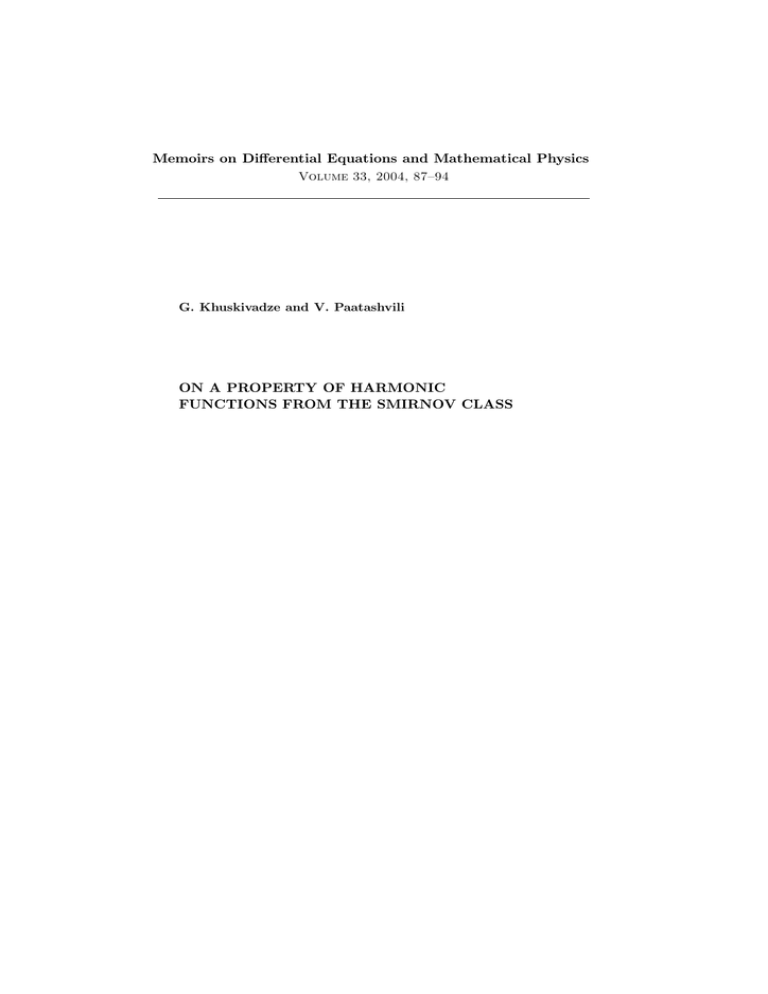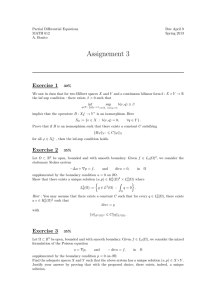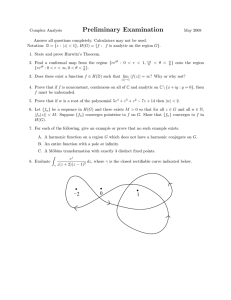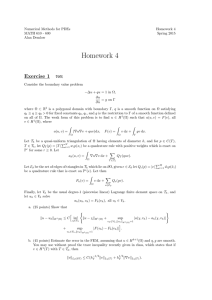Memoirs on Differential Equations and Mathematical Physics
advertisement

Memoirs on Differential Equations and Mathematical Physics
Volume 33, 2004, 87–94
G. Khuskivadze and V. Paatashvili
ON A PROPERTY OF HARMONIC
FUNCTIONS FROM THE SMIRNOV CLASS
Abstract. It is proved that for harmonic functions from the Smirnov
class e(L1p (ρ1 ), L02q (ρ2 )) (i.e., for functions satisfying the inequality (2)) in a
simply connected domain with the Lyapunov boundary L almost everywhere
on L there exist the angular boundary values which on the part L2 of the
boundary form an absolutely continuous function.
2000 Mathematics Subject Classification. 31A05, 35J05.
Key words and phrases: Harmonic functions, Smirnov classes of harmonic functions, Zaremba’s problem, absolute continuity.
"!#
$ % & '( &
& ( & e(Lp(ρ1 ), L0 (ρ2)) ) & +* !
$ % & '( & # ,
-* . /0# & 2q 1 ! /) 2 ( & L & 34( &" $ 5 ,
) #6 ' '$ &"1 ( 7 L, 38+ & &+ '9 #& & 34( ( :& 3#4( & L2 ;8 3#);# 7 & & ##,
<8;#1 ( =!#
$ % & >
89
On a Property of Harmonic Functions from the Smirnov Class
The boundary value problems for harmonic functions are, as usual, considered in different functional classes and the character of their solvability
depends considerably on the choice of a class of unknown functions.
When considering Zaremba’s mixed boundary value problem, the boundary of the domain is divided into two parts L1 and L2 and it is required to
find a harmonic function from a class A such that on the portion L1 the
boundary function of that function and on the portion L2 the boundary
function of its normal derivative take preassigned values. In the capacity of
the class A, one of the possible sets is the set of harmonic functions such
that the integral p-means are bounded “near” L1 and the integral q-means
of their partial derivatives are bounded “near” L2 . Since in the role of L1
and L2 there appear finite unions of arcs, it is natural to consider weighted
integral means with singularities at the ends of those arcs.
Proceeding from the above reasoning, in the works [1, 2] the authors,
in connection with the study of Zaremba’s problem, have introduced the
classes e(L1p (ρ1 ), L02q (ρ2 )).
As far as the boundedness of integral means is taken as the basis in determining Smirnov classes of analytic functions, the above-introduced class
is naturally called the Smirnov class of harmonic functions.
In [1, 2], the solution of the mixed boundary value problem, besides its belonging to the class e(L1p (ρ1 ), L02q (ρ2 )), is required to be absolutely continuous on L2 . However, it turns out that any function from the above-indicated
class possesses the latter property. In the present paper we prove this fact.
In Section 10 we present the definition of the class e(L1p (ρ1 ), L02q (ρ2 )) and
cite some properties of functions from that class established in [2] which will
be needed in the sequel. In Section 20 we prove absolute continuity on L2
of the boundary function of the function from e(L1p (ρ1 ), L02q (ρ2 )).
10 . Let D be a simply connected domain bounded by a simple rectifiable
curve L and let Lk = (Ak , Bk ), k = 1, m be arcs lying separately on L. By
C1 , C2 , . . . , Cm we denote the points Ak , Bk taken arbitrarily. Assume L1 =
m
∪ Lk , L2 = L\L1. D1 , D2 , . . . , Dn denote the points on L different from
k=1
Ck ; note that the points D1 , . . . , Dn1 are located on L1 while Dn1 +1 . . . Dn
on L2 . Assume
ρ1 (z) =
n1
Y
k=1
|z − Dk |αk , ρ2 (z) =
2m
Y
k=1
|z − Ck |αk
n
Y
k=n1 +1
|z − Dk |βk .
(1)
Let z = z(w) be the conformal mapping of the unit circle U = {w : |w| < 1}
onto the domain D, and let w = w(z) be the inverse mapping. Suppose Γ1 =
w(L1 ), Γ2 = w(L2 ), Γj (r) = {w : w = reiθ , eiθ ∈ Γj }, Lj (r) = z(Γj (r)).
We say that a harmonic in the domain D function u(z), z = x + iy = reiθ
belongs to the class e(L1p (ρ1 ), L02q (ρ2 )) if
Z
Z ∂u q ∂u q q
p
sup
|u(z)ρ1 (z)| |dz|+
(z) + (z) ρ2 (z)|dz| < ∞. (2)
∂x
∂y
r
L1 (r)
L2 (r)
90
G. Khuskivadze and V. Paatashvili
In the case where D coincides with the unit circle, this class will be
denoted by h(Γ1p (ρ1 ), Γ02q (ρ2 )). For Γ1 = γ = {t : |t| = 1} and ρ1 ≡ 1, we
obtain the well-known class hp ([3], p. 373).
Statement 1 (see [2]). If p > 1, q > 1 and for the weights ρ1 and ρ2 we
p
q
, q 0 = q−1
)
have − p1 < αk < p10 , − q1 < γk < q10 , − 1q < βk < q10 (p0 = p−1
0
and u ∈ h(Γ1p (ρ1 ), Γ2q (ρ2 )), then:
(i) there exists σ > 1 such that u ∈ hσ ;
(ii) if v is the function harmonically conjugate to u, then v ∈ h(Γ1p1 (ρ1 ),
pσ
Γ02q (ρ2 )), where p1 = p+σ
;
(iii) if, however, u ∈ e(L1p (ρ1 ), L02q (ρ2 )), then the function U (w) =
u(z(w)) belongs to the class h(Γ1p (ω1 ), Γ02q (ω2 )), where ω1 (w) = ρ1 (z(w)) ×
p
p
× p |z 0 (w)|, ω2 (w) = ρ2 (z(w)) q |z 0 (w)|.
Due to this fact, if u ∈ h(Γ1p (ρ1 ), Γ02q (ρ2 )), then:
(a) almost everywhere on γ there exist angular boundary values u+ (t),
and u(reiθ ) can be represented by the Poisson integral of the function u+ ;
(b) if φ(z) = u(z) + iv(z), then φ ∈ H σ and
Z
sup
|φ0 (z)|q ω2q (z)|dz| < ∞, Θ(Γ2 ) = {θ : 0 ≤ θ ≤ 2π, eiθ ∈ Γ2 } (3)
|z|=r
Θ(Γ2 )
(for the definition of Hardy classes H 6 see [3], p. 388).
20 . Theorem. Let p > 1, q > 1, the weight functions ρ1 , ρ2 be given
by the equalities (1), where αk ∈ (− p1 , p10 ), γk , βk ∈ (− q1 , q10 ), and let u ∈
h(Γ1p (ρ1 ), Γ02q (ρ2 )). Then the function u can be continuously extended to
every closed arc lying on Γ2 . Moreover, the boundary function u+ (t) is such
that there exist the limits
u(Ak −) = lim u+ (t), u(Bk−1 +) =
t→Ak −
lim
t→Bk−1 +
u+ (t),
k = 2, m,
and the obtained in such a way function is absolutely continuous on Γ2 .
+
q
Moreover, ∂u
∂θ ∈ L (Γ2 ; ρ2 ).
Proof. It suffices to consider the case where m = 1, i.e., we assume that γab
is the arc of the circumference γ with the ends a and b, and
Z
sup
(u(reiθ )ρ1 (reiθ ))p dθ+
r
+
Z
Θ(γab )
Θ(γ\γab )
q ∂u
q ∂u
(reiθ ) + (reiθ ) ρ2 (reiθ )dθ < ∞,
∂x
∂y
(4)
where Θ(E) = {θ : eiθ ∈ E, 0 ≤ θ ≤ 2π}.
Let the function v be harmonically conjugate to the function u, and
φ = u + iv. According to Statement 1, φ ∈ H σ ⊂ H 1 , and therefore
φ(z) possesses angular boundary values almost everywhere on γ. Thus in
arbitrarily small neighbourhoods of the points a and b there are the points
91
On a Property of Harmonic Functions from the Smirnov Class
e
α e
e
a = eie
, b = e ib , e
a, eb ∈ γab at which there exist angular boundary values
+
+ e
φ (e
a), φ (b). Moreover,
1
φ(z) =
2π
Z2π
u+ (θ)
0
eiθ + z
dθ.
eiθ − z
(5)
Consider now the domain G ⊂ U which is bounded by the radii passing
through the points e
a, eb and by the arc of the circumference γ e ⊂ γab . Let
e
ab
us show that φ0 ⊂ E 1 (G) (for the definition of the classes E p (G), p > 0,
see [3], p. 422). Towards this end, it is sufficient to construct a sequence of
rectifiable curves γn ⊂ G converging to the boundary for which
Z
sup |φ0 (z)| |dz| < ∞
(6)
n
γn
(see, e.g., [3], p. 422–423).
Let {e
an } and {ebn } be sequences of points on γab , converging respectively
αn 1
to the points e
a and eb. Consider the curves γ1n = {z : z = ρeie
, n <ρ<
en 1
1
iβ
rn = 1 − n }, γ2n = {z : z = ρe , n < ρ < rn }, γ3n = {z : z = n1 eiα ,
α
en < α < βen }, γ4n = {z : z = rn eiα , α
fn < α < βen }, where we put
4
α
en = arg e
an , βen = arg bn and let γn = ∪ γjn , n > 2. It is obvious that γn
j=1
converges to the boundary G. Let us prove that the inequality (6) is valid
for γn .
Let r < rn < ρ; choose a point eiα between a and e
a and a point eiβ
+ iα
e
between b and b with the condition that there exist φ (e ) and φ+ (eiβ ).
We write (−2πiφ0 ) in the form
0
iϕ
−2πiφ (re ) =
Zβ
α
ρφ(ρeiθ )deiθ
+
(ρeiθ − reiϕ )2
iϕ
Z
2π\[α,β]
ρφ(ρeiθ )deiθ
=
(ρeiθ − reiϕ )2
iϕ
= φ1 (re ) + φ2 (re ).
(7)
Since the distance from γn to the arc γ\(eiα , eiβ ) is positive, we get
Z
Z
sup |φ2 (z)| |dz| ≤ M1 sup
|φ(ρeiθ )|dθ < ∞.
(71 )
n
ρ
γn
Θ(γ\γab )
Estimate now the integrals of φ1 .
Z
γn
|φ1 (z)| |dx| ≤
4 Z
X
j=1γ
jn
|φ1 (z)| |dz| =
4
X
j=1
Ijn .
(72 )
92
G. Khuskivadze and V. Paatashvili
We have
I1n
Zrn Zβ
1
iθ d
=
φ(ρe ) dθ ρeiθ − reiαn dr =
α
1/n
=
Zrn
1/n
+
Zβ
φ(ρeiβ )
φ(ρeiα )
−
−
ρeiβ − reiαn
ρeiα − reiαn
iα
+
α
iβ
φ0 (ρeiθ )
iθ de
dr.
ρeiθ − reiαn
(8)
Since φ (e ) and φ (e ) exist and the distance from the points ρeiβ ,
ρe to γ1n is positive, it follows from (8) that
Zrn 0 iθ iθ φ (ρe )de I1n ≤ M +
ρeiθ − reiαn dr ≤
iα
1/n
≤M+
Zrn Zβ
1/n
q
α
dr = M + Jn .
θ−αn
|φ0 (ρeiθ )|dθ
(ρ − r)2 + 4ρr sin2
2
Next, taking into account that n ≥ 3 and sin x >
Zβ
Jn ≤
α
0
Zrn
iθ
|φ (ρe )|
q
1/n
π
≤ √
2 ρ
Zβ
α
Zβ
≤ M1
α
0
iθ
|φ (ρe )|
(ρ −
Zrn
1/n
0
iθ
|φ (ρe )|
2
πx
for |x| <
dr
Zr
1/n
r)2
(9)
+ 4ρr sin2
θ−αn
2
π
2,
we have
≤
dr
dθ ≤
√ q ρ−r 2
r ( θ−αn ) + 1
q
dr
ρ−r 2
( θ−α
)
n
dθ.
(10)
+1
Assuming (ρ − r)|θ − αn |−1 = x, we obtain
Zr
1
q
=
ρ−r 2
|θ
−
αn |
( θ−αn ) + 1
ρ
|θ−αn |
Z
ρ
|θ−αn |
√
0
dx
+
x2 + 1
Z
1
The inequality (9) implies that
Jn ≤ M 2
Zβ
α
Z
dr
0
≤
ρ
|θ−αn |
0
iθ
iθ
q
|φ (ρe )ρ2 (ρe )| dθ
√
ρ−rn
|θ−αn |
|θ − αn |dx
√
≤
x2 + 1
1 dx
≤ 1 + ln .
θ − αn
x2 + 1
1/q Zβ
α
dθ
|ρ2 (ρeiθ ) ln |θ − αn | |q0
1/q0
.
93
On a Property of Harmonic Functions from the Smirnov Class
Taking into account that γk < q10 , the last inequality, (3) and (9) allow
us to conclude that sup I1n < ∞. Just in the same way we can establish
n
that sup I2n < ∞. The estimate for I3n is obvious.
n
Further,
I4n =
Zβen
Z
|φ0 (rn eiθ )|dθ ≤
α
en
|φ0 (rn eiθ )|dθ,
Θ(γab )
and from (3) it follows that sup I4n < ∞.
n
Thus sup Ijn < ∞, j = 1, 4, and therefore (7), (71 ) and (72 ) show that
n
the inequality (6) is valid. In particular, we conclude that angular boundary
values φ0 (t) exist almost everywhere on γeaeb for any e
a, eb ∈ γab at which φ+ (e
a),
+ e
0
e
φ (b) exist. Since such e
a and b lie arbitrarily close to a and b, lim φ (reiθ )
r→1
exists almost everywhere on Θ(γab ). By Fatou’s lemma, the expressions (3)
yield
Z
|φ0 (eiθ )ρ2 (eiθ )|q dθ < ∞.
(11)
Θ(γab )
In view of the inequalities − q1 < γk < q10 , − 1q < βk <
to establish the existence of ε, ε > 0, such that
Z
|φ0 (eiθ )|1+ε dθ ≤ M < ∞.
1
q0 ,
it is not difficult
(12)
Θ(γab )
Since φ0 ∈ E 1 (G), the function φ(z) is continuous on G and φ(t) = φ+ (t)
is absolutely continuous on the boundary of G (see, e.g., [4], p. 208). Thus
φ(t) is absolutely continuous on the arcs γeaeb and, consequently, is such on
every closed arc lying on γab . Moreover,
iθ
φ(e ) =
Zθ
α
φ0θ (eiθ )dθ − φ(eie
),
α
e
e
α
e ≤ θ ≤ β.
(13)
From (12) and (13) it follows that the limits
lim
θ→(arg a)+
φ(eiθ ) = φ(a+),
lim
θ→(arg b)−
φ(eiθ ) = φ(b−)
exist. Therefore the representation (13) is valid for any θ, eiθ ∈ γab if
α
we replace φ(eie
) by φ(a+). Hence φ(t) is absolutely continuous on γ ab .
Moreover, the inequality (11) holds. Since u(z) = Re φ(z), this implies that
all the assertions of the theorem about the function u(z) are true.
Incidentally, we have proved the following
94
G. Khuskivadze and V. Paatashvili
Statement 2. If φ ∈ H 1 and for some ε > 0
sup
r
Zβ
α
| Re φ0 (reiθ )|1+ε dθ < ∞, 0 ≤ α < β ≤ 2π,
then φ(z) is continuously extendable to every closed arc lying on the arc γ ab
with a = eiα , b = eiβ , there exist the limits
lim φ+ (t) = φ+ (a+),
t→a+
lim φ+ (t) = φ+ (b−)
t→b−
and the function φ+ (t) is absolutely continuous on γ ab .
Let z = t(s) be the equation of the curve L with respect to the arc
coordinate. Taking into account the property of the absolute continuity of
the function w(t(s)) with respect to s on [0, l] and of the function z(eiθ )
with respect to θ on [0, 2π], due to the fact that in the case of Lyapunov
curves we have 0 < m ≤ |z 0 (w)| ≤ M (see, e.g., [3], pp. 405, 407, 411),
one can, using the above-proven theorem, establish that the statement of
the above theorem is valid for any functions of the class e(L1p (ρ1 ), L02q (ρ2 ))
if L is Lyapunov curve.
References
1. G. Khuskivadze and V. Paatashvili, Zaremba’s problem in one class of harmonic
functions. Proc. A. Razmadze Math. Inst. 132(2003), 143–147.
2. G. Khuskivadze and V. Paatashvili, On Zaremba’s boundary value problem for
harmonic functions of Smirnov classes. Mem. Differential Equations Math. Phys.
32(2004), 29–58.
3. G. M. Goluzin, Geometric Theory of Functions of a Complex Variable. (Russian)
Nauka, Moscow, 1966.
4. I. I. Privalov, Boundary property of one-valued analytic functions. (Russian) Nauka,
Moscow, 1950.
(Received 24.06.2004)
Authors’ address:
A. Razmadze Mathematical Institute
Georgian Academy of Sciences
1, Aleksidze St., Tbilisi 0193
Georgia







